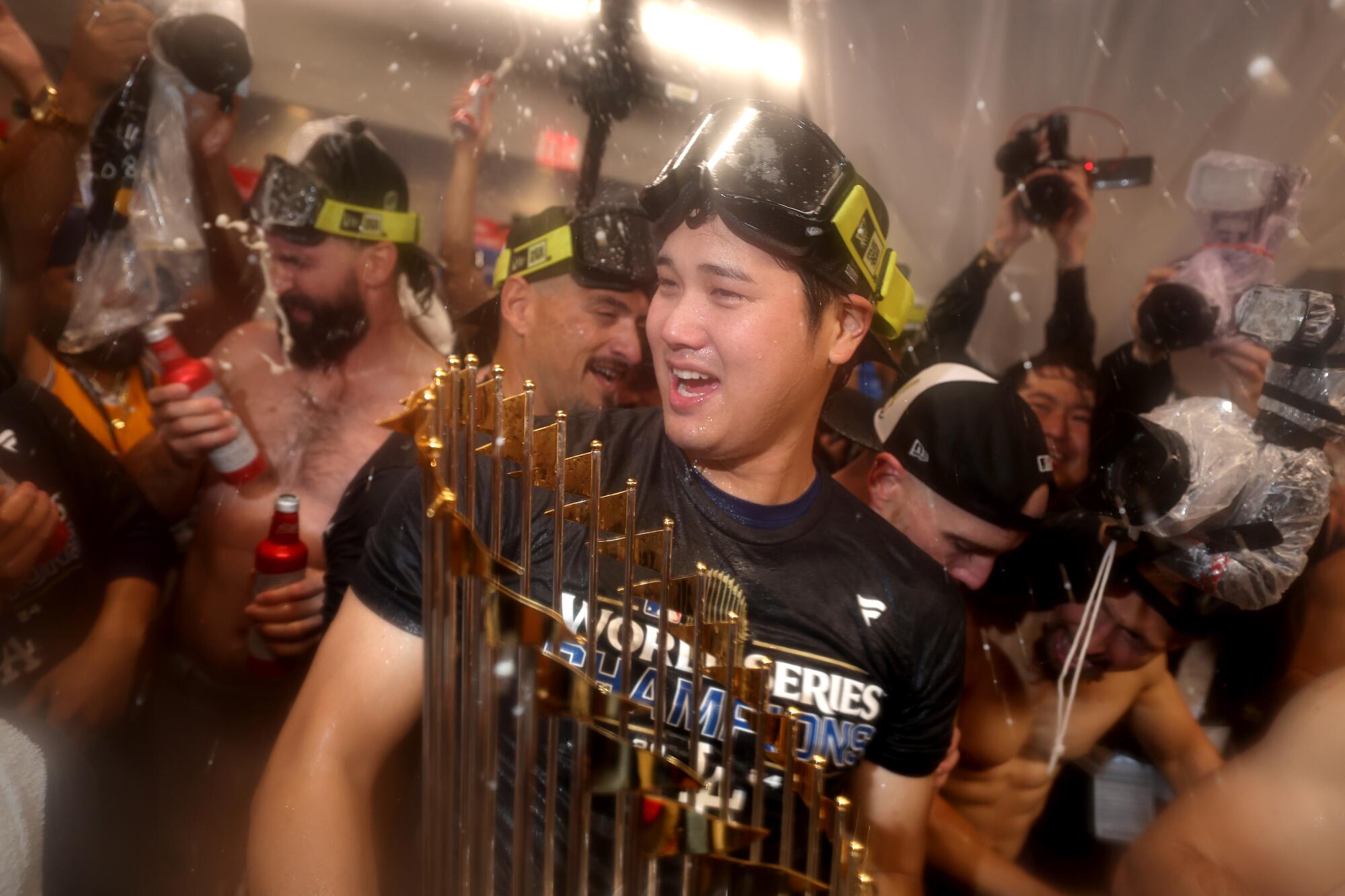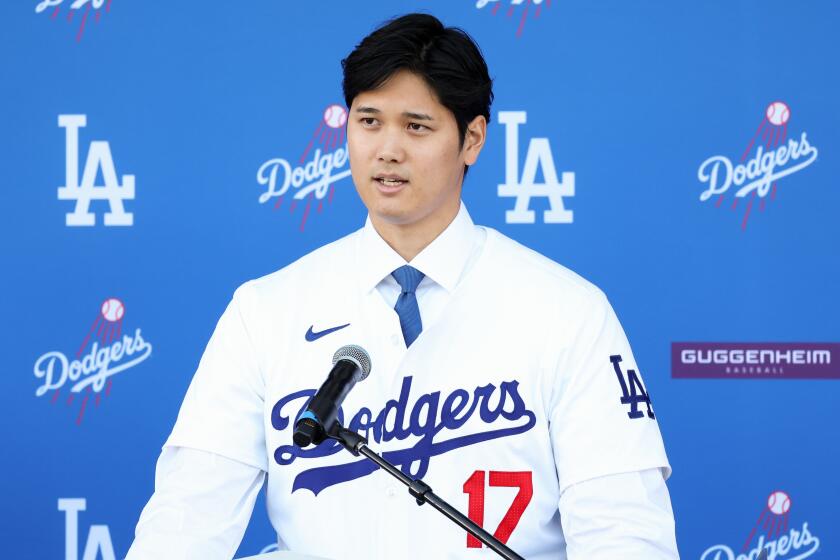
- Share via
The announcements came like a metronome at the start of last season, a steady stream of almost weekly news releases from the Dodgers announcing one Japanese sponsorship deal after the next.
April 1: Dodgers and All Nippon Airways (Japan’s biggest airline) announce multi-year partnership.
April 4: Dodgers and Toyo Tires (one of Japan’s biggest tire companies) agree to multi-year partnership.
April 8: Dodgers and Kowa (a Japanese trading and manufacturing company) announce multi-year partnership.
April 22: Dodgers and Daiso (a Japanese retailer) enter into multi-year partnership.
On and on it went this year, with the Dodgers striking agreements with Japan-based companies producing everything from personal-care cosmetics (Kosé) to fermented dairy drinks (Yakult) to electric vehicles (Afeela).
Shohei Ohtani, baseball’s top free agent, agrees to a $700-million deal with the Dodgers. Here’s everything you need to know about Ohtani joining the Dodgers.
It was the kind of barrage the Dodgers were anticipating when they signed Shohei Ohtani a year ago today, recognizing the global attention — and lucrative marketing potential — the two-way star and three-time MVP had after signing a heavily deferred 10-year, $700-million contract.
Twelve months later, however, top Dodgers executives have acknowledged that Ohtani’s influence exceeded even their lofty ambitions.
In the same way Ohtani’s bat transformed the Dodgers’ World Series-winning lineup on the field, his celebrity redefined the club’s business capabilities off of it.
“We do our best to capitalize on whatever opportunities we have, and I think we were well prepared for it,” team president Stan Kasten said. “But what we weren’t prepared for was how significant his impact would be. It really transcended any of our plans. It just did.”
None of this comes as a major surprise.
Near the end of Ohtani’s tenure with the Angels, the Japanese superstar was believed to generate roughly $10 million to $20 million annually in extra revenue for the club. Many of the companies advertising in Dodger Stadium now had signage plastered all over Angel Stadium before.
Upon his signing with the Dodgers, such Ohtani-related revenues were only expected to grow. After all, they were the more popular Southland team. They had a globally recognizable brand. And even before accounting for the staggering $680 million of deferrals Ohtani proposed in his contract — a structure that preserved the Dodgers’ payroll flexibility by paying him only $2 million in salary each year — some industry experts predicted he could be worth at least three times as much to his new team.
Turns out, that might have been low-balling the value.
In addition to the windfall of corporate sponsorship money, the Dodgers saw increases in ticket sales, merchandising and even tours of Dodger Stadium (the team has been told by Japanese tourism officials that more than 80% of people who visit Los Angeles from the country go to the ballpark during their trip).

As Ohtani helped the club to its first full-season World Series since 1988, officials noticed a renewed “buzz in the community,” as chief marketing officer Lon Rosen said, “that means more people are thinking about the Dodgers and buying more merchandise and more tickets and more hot dogs and more everything.”
While the team declined to disclose specific Ohtani-related revenue totals, some reports now estimate the player’s annual influence on the franchise to be in the nine-figure range. Tack on the investment opportunities his salary deferrals create, and the forecasts of him being a billion-dollar profit machine for the franchise seem on track.
“Because he helps create a winning culture, he makes business better,” Rosen said. “Whether it’s in sponsorship or merchandise or ticket sales. You name it, he does it.”
“If you’re only going to count the $2 million [of his salary] from this year,” Kasten deadpanned when asked about Ohtani’s impact on the team’s bottom line, “I’m gonna say we cleared that hurdle.”
As a result, if the Dodgers weren’t baseball’s biggest financial goliaths before, they might be now.
While the team has consistently carried some of MLB’s highest payrolls since being purchased by Mark Walter’s Guggenheim investor group in 2012, Ohtani’s arrival has triggered a new era of spending never before seen at Chavez Ravine.
Before Ohtani, the Dodgers had agreed to six $100-million contracts in club history, and often appeared wary of shelling out monster deals for top free agents.
Including Ohtani, the franchise has now struck five such deals in the last year, most recently landing two-time Cy Young Award winner Blake Snell for $182 million last month.
“We always have been good, and we always have been aggressive,” Kasten said. “But [having Ohtani] makes us attractive as a landing spot for players. So is there a little bit of striking while the iron is hot? We certainly felt that way. We have a greater offering than ever.”
The Dodgers have reached a two-year, $22-million deal with Blake Treinen, a key part of their World Series-winning bullpen.
Granted, several of the Dodgers’ recent mega-deals have included significant deferrals prompting complaints from some corners of the baseball industry that the deep-pocketed Dodgers are gaining an even bigger economic advantage on the rest of the league. However, each of those deals also come with hefty signing bonuses, including $52 million for Snell, $50 million for Yoshinobu Yamamoto, $30 million for Will Smith and $10 million for Tyler Glasnow.
It’s a contract structure that works for all involved parties: The Dodgers get to reduce the hit against their luxury tax payroll, while players preserve the present value of their deals.
Yet, it’s a strategy that requires the team to pay a lot of cash up front.
Enter Ohtani, who structured his contract with the Dodgers explicitly in hopes of enabling the team do exactly that in pursuit of fellow star players.
“The pledge that we made when we met with him about how aggressive we were going to be to try to win, we feel some responsibility and obligation to fulfill that,” president of baseball operations Andrew Friedman said last week.
Would the Dodgers have been able to spend this big — their 2025 luxury tax payroll is already estimated at over $300 million, with several more signings expected to come — if they didn’t have Ohtani?
“Fortunately,” Friedman said, “we don’t have to spend much time thinking about that alternate reality.”
Ohtani’s financial benefits aren’t entirely exclusive to the Dodgers.
Juan Soto agrees to a record-breaking deal with the Mets as the Dodgers sign former Giants and Mets outfielder Michael Conforto.
His popularity has helped promote the sport on a global stage. His first career postseason appearance this year drove up television ratings throughout October. And companies who couldn’t land a sponsorship agreement with the Dodgers have resorted to buying ad space in other clubs’ ballparks for when Ohtani comes to town.
“That’s power of Shohei,” Rosen said. “It’s almost like a Shohei economy for baseball.”
No one, though, has prospered more than the Dodgers.
They got a superstar player that keyed a championship run. They got a sponsorship darling that has amplified the team’s revenues. And, just one year into their decade-long partnership, the influence of it all is becoming increasingly more clear, allowing the Dodgers to flex their financial muscles in ways they could have never imagined.
The offseason becomes an unabashed success for the Dodgers after Japenese phenom Roki Sasaki and top reliever Tanner Scott join an already impressive haul.
More to Read
Are you a true-blue fan?
Get our Dodgers Dugout newsletter for insights, news and much more.
You may occasionally receive promotional content from the Los Angeles Times.















